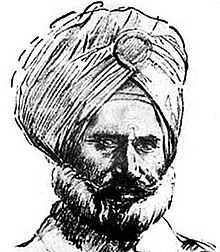Ishar Singh (1858 – 12 September 1897), IOM, IDSM was an Indian-Sikh Havildar and war hero of the 36th Sikhs. He was known leading the regiment on a last stand against the 10,000-12,000 strong Pashtun tribesmen with only 20 other men at the Battle of Saragarhi. After sustaining enough resistance, Singh was fighting alone but refused to surrender and fought to the death along with the rest.[1]
Havildar Ishar Singh | |
|---|---|
 A sketch of Havildar Ishar Singh | |
| Birth name | Ishar Singh |
| Born | 12 September 1858 Jhorran, Ludhiana district, Punjab Province |
| Died | 12 September 1897 (aged 39) Saragarhi Fort, Kohat district, Punjab Province |
| Allegiance | |
| Branch | |
| Years of service | 1876–1897 |
| Rank | Havildar |
| Commands held | 36th Sikhs |
| Battles/wars | Tirah Campaign |
| Spouse(s) | Jeevani Kaur |
| Relations | Sardar Dulla Singh (father) |
Early military career edit
He was born in 1858, at the village of Jhorran (near Jagraon) in the Ludhiana district of Punjab, to an Gill Jat Sikh agrarian family of Sardar Dulla Singh. Singh had an aspiration for becoming a soldier and when he turned 18, he joined the Punjab Frontier Force. He was initially assigned to Regiment No. 165 of the Regiment before being drafted in the 36th Sikhs Regiment in 1887. Major General James Lunt described him as:
Ishar Singh was a somewhat turbulent character whose independent nature had brought him more than once into support with his military superiors. Thus Ishar Singh — in camp, a nuiscance, in field, magnificent.
Battle of Saragarhi edit
Despite initial British success within the Samana Range, the Pashtuns continued to harass the British forces. Near the area stood Fort Lockhart and Fort Gulistan but both weren't visible due to the mountainous terrain. As a result, the Saragarhi outpost was established to give easier communications between the two forts but after the Pashtuns allied with the Afridis, the outpost became endangered from local uprisings which combined to a force of 10,000 to 12,000.[2][3]
By this point, Singh was in his early 40s, given full command of Saragarhi and was married but had no children.[4] With the small garrison consisting of 2 other NCOs and 18 soldiers, all 20 men led by Singh fought to the death. With no water or food, the Sikhs fought for 8 hours, managing to kill 4-500 men with each Sikh killing at least 20 Pashtuns before they all were killed in the battle (nevertheless, the casualty rate between the Indian soldiers and the Pasthun tribals remained 20:1, as compared to the strength on both sides).[5]
Legacy edit
In recognition of their supreme sacrifice, the British Parliament rose to pay them respect, and each one of them was posthumously awarded the Indian Order of Merit and the Indian Distinguished Service Medal.[6]
The service of the 36th Sikhs has been memorialized by the Sikhs as the day of the battle, September 12th. It is celebrated as "Saragarhi Day".[7]
Singh was portrayed by Akshay Kumar in the 2019 film Kesari.[citation needed] He was also portrayed by Randeep Hooda for the book cover of The 36th Sikhs in the Tirah Campaign 1897-98 – Saragarhi and the defence of the Samana forts by Amarinder Singh.[4]
On September 12, 2021, a statue of Singh was erected at Wolverhampton, West Midlands to commemorate the 124th anniversary of the battle.[8]
References edit
- ^ Jangveer Singh. "The saga of sacrifice at Saragarhi: It is still on the fringes of Indian history". Tribune India. Retrieved September 7, 2022.
- ^ Tom Lansford (2017). Afghanistan at War: From the 18th-Century Durrani Dynasty to the 21st Century. p. 408. ISBN 9781598847604.
The Orakzais were joined by Afridis swelling their numbers to more than 10,000. Groups of the tribesmen attacked Sangar on the night of September 11. The post was on a high ridge and well fortified. Although there were only 44 Sikh troops, the garrison repulsed the attack. The following morning, the natives attacked Saragarhi. The garrison numbered 20 Sikhs, led by Havildar Ishar Singh. Instead of withdrawing to one of the other posts, the Sikhs decided to remain in an effort to maintain communication between the two forts.
- ^ Sharma, Gautam (1990). Valour and Sacrifice: Famous Regiments of the Indian Army. Allied Publishers. p. 185. ISBN 978-8170231400. Retrieved 22 February 2019.
A mass attack came on Saragarhi on September 12 and the 21 strong detachment fought one of the most unequal engagements in the history of warfare. There were fierce onslaughts by the 10,000 Orakzai and Afridi tribesmen. The outnumbered defenders returned the fire in a most determined manner. After a series of abortive attempts, the tribesmen managed to reach the wall of the post by using an ingenious method. Effecting a breach, they were face to face with the Sikh garrison, most of whom were wounded.
- ^ a b Manraj Grewal Sharma (September 14, 2021). "Explained: Why the Battle of Saragarhi continues to inspire India & world, 124 years on". The Indian Express. Retrieved September 7, 2022.
- ^ Saragarhi Battalion: Ashes to Glory ISBN 8170620228 by Kanwaljit Singh and H.S.
- ^ C.C. Jackson (January 11, 2012). History of the 4th Battalion 16th Punjab Regiment. Naval & Military Press. p. 152. ISBN 9781781498194. Retrieved September 7, 2022.
- ^ Shri (28 August 2019). "21 Sikhs clashed with ten thousand Pathans- Battle of saragarhi". Meramaal. Retrieved 31 January 2020.
- ^ Neel Kamal (September 13, 2021). "124 years on, Saragarhi valour immortalised in UK". Times of India. Retrieved September 7, 2022.